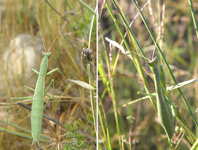Abstract
The Neotropical praying mantis genus Miobantia Giglio-Tos, 1917 currently includes six species with a complex taxonomic history. Although frequently found in the atlantic forest of Brazil, little is known about these species. Several obstacles make it difficult identifying these mantids, including high levels of sexual dimorphism and both sexes known only for one of the six currently known species. The taxonomic boundaries among the species of Miobantia are proposed in this work, through a cladistic analysis using 99 morphological characters, and the analysis of sequence variation of approximately 700 bp of the mithocondrial gene COI for association of dimorphic sexes and nymphs. Additionally, an investigation of intraspecific variation is conducted based on a large number of specimens of M. fuscata (Giglio-Tos) in oder to choose the most relevant features for the separation of the species to be used in taxonomic descriptions and identification keys. The male of M. aptera Giglio-Tos, and the females of M. ciliata (Stål) and M. fuscata are described for the first time, and redescription of the males of these and the female of M. aptera, are provided based on additional data. Miobantia nebulosa (Giglio-Tos) is herein redescribed (male genitalia included) and proposed as a junior synonym of M. rustica (Fabr.). Additionally, four new species are here described, totaling nine species for the genus: M. immanis n. sp. (Espírito Santo, Brazil), M. arctissima n. sp. (Espírito Santo, Brazil), M. sulista n. sp. (Santa Catarina and Rio Grande do Sul, Brazil; San Bernardino, Paraguay), and M. nordestina n. sp. (Bahia, Brazil); both sexes of all new species are described, except for M. arctissima, which remain known by males only. Identification keys and figures of diagnostic features are provided for both males and females of all valid species. The species distribution is mapped according to literature data and 50 new records.

